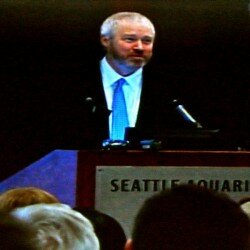Op-Ed: For Rail, Be Bold (by Mayor McGinn)
“For Rail, Be Bold,” reprinted by permission from Mayor McGinn’s blog.
“If you’re going to ask for $80,” I wrote a few days ago, “you need to show exactly how that money is going to be spent, and how it’s going to benefit Seattle. Squishily ‘maintaining’ and ‘improving’ isn’t going to win you votes, and bike paths will likely lead to your summary execution.”
Mayor McGinn has responded to the call, with a call for streetcar funding (and bus rapid transit, which isn’t as sexy). Seattle Transit Blog agrees the $80 level is the one that moves the needle. Seattle’s City Council, though, will likely need to be persuaded that $80 doesn’t vote them out of office.–Ed.
As the City Council deliberates on a new transportation measure, it is important to recognize that there is an opportunity here for expanded rail transit in Seattle — if the council can be bold.
First some background. In 2010, the City Council and I appointed a Citizens Transportation Advisory Committee, to advise the city on how to finance its transportation needs, now and in the future. At the same time, the Transit Master Plan process was launched, also advised by a diverse set of residents.
The Transit Master Plan showed that Seattle’s greatest weakness was connecting neighborhoods to each other. It identified fifteen corridors overall, five of which will need high capacity service – and four of these are suitable for some form of rail transit. To some degree, we’ve all known this, but the rigorous approach of the Transit Master Plan clearly identifies the best corridors, and points to the better ways to serve each corridor. In a number of cases, it points to rail, specifically a concept that has come to be known as “rapid streetcar.” Unlike Sound Transit’s Link light rail, it operates in the right of way, making it cheaper and faster to build. To ensure it moves rapidly, it has high priority in the right of the way.
For the distances served — neighborhood to neighborhood — it looks like the right choice for a number of corridors in Seattle. That includes Ballard to downtown via Fremont, the University District to downtown via Eastlake, and linking those to Seattle’s two initial streetcar lines to South Lake Union, the International District/Chinatown and Capitol Hill. Other cities have already demonstrated the promise of this approach, like Portland with its MAX system.

MAX train running in street right of way in downtown Portland
Until now, Seattle has always thought we could only afford more rail the Sound Transit way – wait for a regional vote, and take decades to build it. But for local transit, the Citizens Transportation Advisory Committee pointed to a different way: Use our local taxing authority to create a dedicated transit fund to expand neighborhood to neighborhood high capacity transit.
The committee recommended an $80 VLF. Much of it goes to catching up on deferred maintenance, which I support. 49% percent goes to implement the Transit Master Plan, to catch up on our deferred transit needs. As a permanent funding source, this could fund the following in the next ten years: planning and alternatives analysis for all five high capacity corridors in the Transit Master Plan, planning and construction for connecting the two streetcar lines through downtown, speed and reliability improvements on half of all non-high capacity transit corridors, and substantial upgrades to our electric trolley bus infrastructure. Over the next twenty years, we could make good on the Transit Master Plan’s stated need to accommodate substantially more travelers on each of the high capacity corridors the Plan identified.
But here is the problem. The City Council is only considering a VLF for a limited amount of time, after which it expires. For this amount of money, all you can do is study a single corridor. You cannot finance long term infrastructure with a short term financing plan. You cannot get in the queue for federal, regional, or state funds because there will be no source of funds for us to put up our local match. The Transit Master Plan will join the Pedestrian and Bicycle Master Plans as nice plans, without serious funding.
There is a better way, and here is where boldness is required. If the VLF is ongoing, it becomes a steady source of revenue that can be borrowed against to build rail that will serve us for decades. It is how Sound Transit finances Link light rail, by borrowing against its statutory taxing authority. It is how the Washington State Department of Transportation finances major projects. It is how Los Angeles Mayor Antonio Villaraigosa is planning to build a major expansion of rail in his city. In fact, even Seattle does it. We put into place a permanent parking tax that we bonded against to pay for the Spokane Street Viaduct and the Mercer Corridor, among others.
So, the question is now on the Council — can it do for transit what it does for major road projects, and commit to a long term funding source that will begin building the rail system Seattle needs and wants? If the answer is yes, we will begin the work of expanding rail to connect neighborhoods to each other, to downtown, and to the Link Light Rail system.
If the answer is no, I will not stop working to fulfill my commitment to expand rail in Seattle. But it means we’ll have to keep coming back for the capital funding for transit, so that the Seattle Transit Master Plan does not become a pretty plan gathering dust on a shelf. And so that Seattle will realize its transit future.


 Daily Email Digest of The SunBreak
Daily Email Digest of The SunBreak